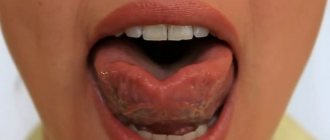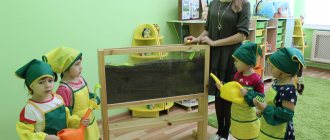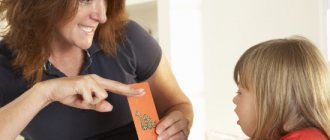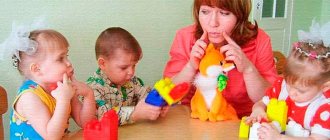At first, this usually does not bother parents - they are even touched by the helpless babble of children, and they themselves repeat funny children's words. As time passes, speech gradually improves. But is it always? Unfortunately no. Sometimes a child gets used to pronouncing sounds incorrectly, and what at first seemed cute and funny becomes unpleasant to outsiders and, most importantly, harmful to the child himself.
Speech deficiencies can delay mental development: after all, speech not only serves as an expression of thought, but also shapes thinking. If a child does not learn to speak correctly before entering school, he will make mistakes in writing and reading. He won’t have to read poetry at a children’s matinee or participate in a play with other children. How many joys such a child will lose and how many tears he will have to shed!
So, you are seriously concerned about eliminating pronunciation defects in your child. Where to begin? First of all, you need to find out exactly what mistakes he makes. Most often, children incorrectly pronounce hissing (Sh, Zh, Ch, Shch), sonorant (R, L), and whistling (S, 3, C).
Prepare a series of pictures that you will use to check the purity of pronunciation of sounds. Show them by asking them to name the objects depicted on them. It is important that the child names them himself, and does not repeat the word after you - in the latter case, the assessment of his speech will be less accurate.
Each sound is tested in different combinations, so it must correspond to at least two pictures. For example, for the sound Ш - hat, pencil, for Р - pencil, fireman, sugar, for И - bunny, tongue, egg, Christmas tree, box.
What variants of the wrong sound need to be caught?
There can be four of them:
The child does not make any sound at all. He says Apka instead of a hat or kAAndash instead of a pencil.
Replaces one sound with another. Then he pronounces Sapka instead of hat or KaLandash instead of pencil.
Distorts the sound. In this case, he replaces the desired sound with another that does not exist in the Russian language. For example, pronounces the sound C with the tip of the tongue protruding between the teeth or pronounces P gutturally, etc.
Uses sound inconsistently. The child pronounces it correctly in some words, but not in others (ocucumber, but Syplyata, YaiSo) or can pronounce the sound in isolation, but does not use it in words or in independent speech.
Your task is to trace as carefully as possible why the child’s sound is incorrect, what is the mechanism of its disturbance. Experience shows that most often the cause is a violation of the movements of the speech organs (tongue, lips) and auditory perception. That is why it is imperative to find out whether the child’s tongue and lips are mobile enough. To do this, do the following exercises with him:
1. Open your mouth. Without closing it, stick out the tip of your tongue and hide it. Repeat several times.
2. The same thing, but now move the tip of the tongue alternately from one corner of the mouth to another (the “Pendulum” game).
3. The same, but the tip of the tongue makes a circular movement along the lower, upper, lower lip again and in the opposite direction (without touching the opposite lip).
If a child finds it difficult to do these exercises on his own, you need to help him by holding the tip of his tongue with a clean bandage and moving it in the right direction. Subsequently, the child will help himself until the need for this help disappears.
4. Teach your child to use a “spatula” tongue (wide tongue, relaxed). Lightly slap the handle of a teaspoon along the middle of your tongue if it feels tense.
5. Then teach the child to stick out his tense, pointed tongue (“needle”) strongly. It is necessary that the child can make the tongue either a “spatula” or a “needle”.
6. From the “spatula” position of the tongue, it is easy to make the tongue a “tube” if at this moment you lightly squeeze your fingers on both sides of the child’s cheeks and ask him to inhale through his mouth.
7. From the same “spatula” position of the tongue, you can make the tongue “cup” if you slightly bend its tip upward.
8. For the lips, we can recommend exercises in silent pronunciation of the sounds I-U-I-U. Or: show your teeth wide and hide them.
Exercises for the tongue and lips should be done many times, preferably in front of a mirror, so that the child can control his movements. Their goal is to activate the muscles of the speech organs, teach the child to control them, and hold them in a given position. Without this, he will not be able to overcome the incorrect pronunciation of sounds.
Even more important for the formation of good, clear speech is the child’s auditory attention, his perception of the sounds of speech of surrounding people and auditory control of his own speech. To appreciate the significance of the speech of others for a child, let us recall the savage experiment of Padishah Akbar, famous in history. Having decided to test the court sages, who claimed that every child would sooner or later speak the language of his ancestors, even if no one taught him this, Akbar isolated several young children of different nationalities from the world for seven years. A mute man served the children. They had never heard a human voice. When the padishah, in the presence of his sages, finally freed the little prisoners, he was greeted by howls and inarticulate screams. Thus were the wisest of the wise put to shame...
It has been proven that a child’s speech is formed on the basis of his perception of the speech of the people around him, which he initially learns to recognize, distinguish and then imitates. That is why, in order to overcome pronunciation deficiencies, it is necessary that the child be able to recognize and identify speech sounds.
If a child speaks incorrectly! educational and methodological material on the topic
Exercises for speech development
Hearing development
If a child poorly distinguishes sounds by ear, pronounces them distortedly or replaces them with others, then he will not be able to clearly imagine the sound appearance of the word itself. In this case, the following group of exercises will be useful to you.
Exercise No. 1. “Name the words” (for the development of auditory differentiation).
Task No. 1. “Name as many words as possible that begin with the sound A” (T, O, R, K, etc.).
Task No. 2. “Name as many words as possible that end with the sound P” (I, O, S, L, etc.).
Task No. 3. “Name as many words as possible that have the sound L in the middle” (N, E, G, B, F, etc.).
Exercise No. 2. “Clap-clap” (teaching sound analysis of words).
This exercise also has several task options.
1. “Now I will tell you words, and as soon as you hear a word that begins with the sound S (V, O, G, D, W, etc.), you will immediately clap your hands.”
Option: the child must “catch” the sound with which the word ends, or the sound in the middle of the word.
Cottage, cat, hat, fox, road, beetle, window, lump, plate, bread, rain, linden, lamp, river, hair, etc.
2. “Now I will tell you words, and as soon as you hear a word that contains the sound K, clap your hands once. If you hear the sound G in a word, clap twice.”
It is better to start the exercise at a slow pace and gradually increase the speed.
Cow, jelly, mountain, mink, guitar, boot, bitch, hand, caught up, pushed, etc.
This exercise will also help you check how your child is doing with his reaction.
Exercise No. 3. “Playing with the word” (teaching the sound form of a word).
Task No. 1. “Come up with a word that begins/ends with the same sound as in the word “frog”, “flag”, “table”, etc.”
Task No. 2. “Name the first/last sound in the word “ray”, “force”, “sofa”, etc.”
Task No. 3. “Name all the sounds in order in the word “sky”, “cloud”, “roof”, etc.”
Task No. 4. “What sound in the word “fish” is second, fourth, first, third? (chair, carpet, shell, cloud), etc.”
Exercise No. 4. "Confusion".
“Listen carefully to the poem.
| Who is sitting on the tree? Whale. Who swims in the ocean? Cat. What's growing in the garden? Cancer. Who lives under water? Poppy. The words are mixed up! I command “one-two” And I order you to put everyone in their places.” |
Ask your child: “Which words are mixed up? Why? How are these words similar to each other? What is the difference?"
You can give your child a little hint, but the main thing is to lead him to the idea that one sound can completely change the meaning of a word.
Exercise No. 5. “Come up with a new word.”
Assignment: “I’ll now tell you a word, and you try to change the second sound in it so that you get a new word. Here, for example: the house is smoke.” Words to change: sleep, juice, drank, chalk. Words to change the first sound: dot, bow, varnish, day, pedal, layout. Words to change the last sound: cheese, sleep, bough, poppy, stop.
Exercise No. 6. "Circle".
It will be useful to you if your child cannot write.
Assignment: “Now we will write down a few words, but not in letters, but in circles. The number of sounds in a word is the number of circles you will draw. Say the word "poppy." How many circles should you draw? Three".
Sample: MAK - 000
Attention: when choosing words for the exercise, try to ensure that the number of sounds in them matches the number of letters. So, in the word “horse” there are 4 letters and three sounds - [k - o - n']. Such words can cause difficulties for a child.
Words for dictation: grass, paper, pen, bun, stick, chamomile, star, pine, telephone, tablet.
Exercise No. 7. "Longer, shorter."
Assignment: “Now we will compare words. I will say two words at a time, and you will decide which one is longer. Just remember that you need to compare words, not the things they mean. You know that a word is not a thing. For example, the word “nose”. You can say it, or you can write it, but you can’t breathe it, it’s just a word. And with a real nose you can breathe, but you cannot write or read it.”
Words for comparison: table - table, pencil - pencil, mustache - mustache, dog - dog, tail - tail, snake - snake, worm - worm.
Vocabulary development
The quality and quantity of a child’s vocabulary largely determines the level of speech development as a whole. It is very important for you to pay attention to both passive (that is, those words that are stored in memory reserve) and active (words that are constantly used) vocabulary. It is very important that the child knows what meanings a word has and knows how to use it correctly in independent speech. The exercises offered here will help you do this.
Exercise No. 8. "Word Game"
Task No. 1. “Name as many words as possible for fruits” (vegetables, trees, flowers, wild and domestic animals and birds, toys, tools, furniture, professions, etc.).
Task No. 2.
“Now I will tell you the words, and you will tell me what this object can do. A blizzard is blowing, and thunder is ..., wind is ..., and snow is ..., rain is ..., and the sun is ....”
Don’t forget to ask with each answer: “What else does the sun do, it doesn’t just shine?” Let the child choose as many words as possible that denote the action.
Then you can repeat the same game in reverse: “Who flies? Who swims? Who hammers the nails? Who catches mice?
Exercise No. 9. "Sign".
Task No. 1.
“Tell me, if an object is made of iron, what is it called, what is it?”
iron - paper - wood - snow - fluff - glass -
Task No. 2.
“Name another object that is as white as snow.” (As narrow as a ribbon; as fast as a river; as round as a ball; as yellow as a melon).
Task No. 3.
“Compare: to taste - lemon and honey, onion and apple; by color - cloves and chamomile, pear and plum; in terms of strength - rope and thread, stone and clay; in width - a road and a path, a river and a stream; in height - a bush and a tree, a mountain and a hill.”
Exercise No. 10. "Guessing game."
Assignment: “Guess the riddle:
It flies, squeaks, drags its long legs, does not miss the opportunity - it sits down and bites. (Mosquito)
Round, striped, taken from the garden. It has become sugary and scarlet - Eat, please. (Watermelon)
How did you guess what we were talking about? Try to describe some object to me yourself, and I will try to guess who or what it is.”
Exercise No. 11. “Words-buddies” (exercise on synonyms).
Task No. 1.
“What do you think is another way to say something about a sad person?” (Sad) “Valuable - what is it? What kind of hard one is that?”
Task No. 2.
“What word can replace the word “horse”? The word "doctor", "cup", "food"?
Task No. 3.
“Which word is extra, doesn’t fit with other words? Why?"
Sad, sorrowful, despondent, deep Brave, loud, courageous, daring Weak, brittle, long, fragile Strong, distant, durable, reliable
If your child does not understand the meaning of a word, explain it.
Exercise No. 12. “Enemy words” (exercise on antonyms).
Assignment: “Say the opposite:
cold, clean, hard, thick; dull, wet, senior, light; spacious, enemy, top, lose; raise, day, morning, spring; winter, tomorrow, early, close; low, rare, slow, joyful; dark, sat down, took it, found it; forgot, dropped, messed, straightened.
Exercise No. 13. “One and many” (changing words according to numbers).
Task No. 1.
“Now we will play this game: I will name one object with a word, and you name the word so that you get many objects. For example, I will say “pencil”, and you should say “pencils”.
book, pen, lamp; city, chair, ear; child, person, glass; name, spring, friend.
Task No. 2.
“Now let’s try the opposite. I will say a word that denotes many objects, and you will say one.”
claws, clouds, warriors, leaves; flowers, saws, well done, stems.
Exercise No. 14. "Decrease".
Assignment: “Tell me what the small object will be called? A small ball is a ball, and a small table is...”
grass, hand, shoulder, sun, bank; chair, book, flag, cup, hat.
Exercise No. 15. “Finish the word.”
Assignment: “Guess what word I want to say? By...” (Pillow) Syllables with which words can begin: for, mi, mu, lo, at, ku, zo, che, etc.
Exercise No. 16. “Explain the word.”
Assignment: “I want to find out how many words you know. Tell me, what is a bicycle?
knife, hat, ball, letter; umbrella, pillow, nail, donkey; fur, diamond, connect, shovel; sword, trouble, brave, hero; poem, gambling.
The purpose of this exercise is to teach the child not only to recognize new words through explanation, but also to clearly express thoughts, indicating the main type of use of the object, describing its characteristics. You can do all these exercises several times, completing the rows of words yourself.
Development of grammar skills
The next block of exercises is aimed at developing the grammatical structure of speech. Training tasks will help the child learn to correctly compose simple sentences, correctly connect speech structures, and understand the sequence of events in the text.
Exercise No. 17. "Who? What?" (drawing up proposals for different models).
Assignment: “Try to make a sentence that says
Who? What is he doing? What?
For example: The cat laps up the milk."
Who? What is he doing? What? How? (The gardener waters the flowers with water) Who? What is he doing? What? To whom? (The girl sews a dress for the doll)
Exercise No. 18. “Finish the sentence.”
Assignment: “Try to guess the end of the phrase.”
The children ate... There is paper and paper on the table... . Gris grow in the forest... . Flowers grow in the garden... . We have a rooster and... In winter it can be hot… .
Exercise No. 19. “Add words” (spreading sentences).
Assignment: “Now I will say a sentence. For example, “Mom is sewing a dress.” What do you think can be said about the dress, what kind of dress is it (silk, summer, light, orange)? If we add these words, how will the phrase change?”
The girl feeds the dog. Thunder rumbles in the sky. The boy drinks juice.
Exercise No. 20. “Make a phrase” (forming sentences from words).
Task No. 1.
“Make up sentences using the following words:
a funny puppy, a full basket, a ripe berry, a cheerful song, a thorny bush, a forest lake.”
Task No. 2.
“The words in the sentence are mixed up. Try to put them in their place. What will happen?
1. Smoke, coming, pipes, from. 2. Loves, teddy bear, honey. 3. Standing, in a vase, flowers, in. 4. Nuts, in, squirrel, hollow, hiding.
Exercise No. 21. "The Missing Words"
Assignment: “Now I will read you a story. But some words were lost in it. Try to guess which ".
1. Silence reigns in the dense _____. Black ________ covered the sun. The birds fell silent. It's about to go ________.
2. Winter. All paths are covered with fluffy _______. The river was dressed in smooth _______. The guys built a high __________. _______ sleds are rushing fast. A sharp _______ hits the children in the ______. The frost stings _______. ________ are not afraid of frost. Their ________ are burning with joy.
3. The weather is hot: the sky is _______, the sun is shining _______. Kolya and Olya go for a walk in the ______ field. They listen to little ________ singing there. They collect ________. Suddenly the sky becomes dark and is covered with large ________. The little children are in a hurry to return ____. But before they could arrive, ______ erupted. The children were scared ________ thunder. They knocked on one ______ to hide from strong _______, since they do not have ________ with them and their clothes are completely _______.
Exercise No. 22. "Find the mistake."
Task No. 1.
“Listen to the sentences and tell me if everything in them is correct.”
In winter, apple trees bloomed in the garden. Below them lay an icy desert. In response, I nod my hand at him. The plane is here to help people. I soon succeeded by car. The boy broke the ball with glass. After the mushrooms there will be rain. In the spring, the meadows flooded the river. The snow was covered with a lush forest.
Task No. 2.
“How should the sentence be corrected?”
Exercise No. 23. "Explain."
Assignment: “Listen to the phrase:
The dog goes to the kitchen. She drinks the cat's milk. The cat is unhappy.
Explain why the cat is unhappy.
Petya went to the cinema after finishing reading the book. What did Petya do earlier: read a book or go to the cinema? Explain.
Vanya drew Sasha. Sasha was drawing a house.
Who drew what? Explain.”
Exercise No. 24. "What is meant?" (training to understand figurative meaning).
“Tell me how you understand these expressions:
iron ax - iron man golden arrow - golden hands poisonous bite - poisonous look sharp knife - sharp word low table - low deed stale bread - callous man.”
Exercise No. 25. “Right or wrong?”
Assignment: “Do you think it’s possible to say that?”
Mom puts a vase of flowers on the table. When they want to buy something, they lose money. Grandparents live under a house on the edge of the forest. There is a beautiful carpet on the floor.
Ask your child: “Why are the sentences inaccurate?”
Exercise No. 26. “Where is the beginning of the story?”
The child needs to establish the sequence of events from a series of pictures. Show your child a series of pictures
Assignment: “Look, all these pictures are connected. But they are confused. Find where the story begins and ends, and tell me what it’s about.”
Exercise No. 27. "A story from a picture."
Give your child the opportunity to carefully look at the picture and ask him to tell the story depicted in it. This exercise should be repeated as often as possible, using any drawings that are interesting to the child.
Here are some rules that are important to follow when writing a story.
It is important to teach the child to see and highlight the main thing in the content, the features of the story. Help your child by asking questions.
- What is this picture about? —Who is the main character? - What's happening? — What heroes are drawn in the picture? -What is their character? - What can you call this story?
With the same success, you can add text retelling training to this exercise. You read a short story (up to 20 sentences) to your child, then ask him to retell what he heard. At the same time, watch how the child understood the main meaning of the story, whether he can express it verbally, whether he easily finds the right words, whether he allows incorrect grammatical forms in his speech, or whether he uses complex sentences.
Exercise No. 28. "Pick up a rhyme."
First, check if the child knows what a rhyme is. Explain that two words rhyme with each other if they end the same, for example, ox - goal.
Invite your child to independently choose a rhyme for the words:
porridge, howl, pillow, juice; snow, cat, circle, bowl; river, cloud, barrel.
The child needs to choose at least three rhymes for each word.
Exercise No. 29. “Make a proposal.”
Assignment: “Now we will connect several sentences together. For example, I say the sentence: “It is raining in the forest. Thunder". These sentences can be connected using a small bridge word “and”, then the two will turn out to be one. “It’s raining in the forest and there’s thunder.” Now try it yourself."
The sun shines brightly. Birds are singing.
There is another possible version of this exercise: ask the child to finish the phrase.
The children went out for a walk and...
Using the same scheme, you can train your child to compose sentences with conjunctions “a”, “but”, “although”, “but”, “if, ... then”.
Let's play games...
Several exercises and games can be recommended to examine and develop a child’s auditory attention and control.
1) Recognize an object by sound. Take 3-5 sounding toys (rattle, flute, drum, accordion). Introduce your child to the sound of each of them. After that, ask him to turn around and guess which one you just played.
2) Now ask your child to guess what object you tapped with a stick (glass, saucer, cardboard box, plastic toy).
3) Who is this? An adult imitates the cry of animals or birds, the buzzing of insects. The child must guess who he imitated.
4) Are you attentive? On your instructions, the child remembers a sound that is first clearly audible in speech (R, U) or one that he pronounces correctly. Then you say a series of words that contain that sound and those that don't. For example, Fish, Cancer, head, table, trough. The child should raise his hand when he hears a word with the sound R.
5) A variation of the previous game will be determining the place of a given sound in a word (at the beginning, middle, end).
6) A more complex form is a game with pictures. Among them, the child is asked to select only those that depict an object whose name contains a given sound.
7) When the child learns quite freely to identify sounds in words that he pronounces correctly, instruct him to recognize one of the sounds he distorts. Do exercise 4), 5), 6). If he completes the task, make this sound. Ask them to repeat it after you.
If a child finds it difficult to complete the exercises, do not rush him, do not get upset and practice on the previous material, which can be varied: change toys, pictures, take on new words.
 An even more complex form of sound analysis is the comparison of two sounds that are similar in sound or articulation (position of the speech organs): S-3, P-B, Sh-Zh, Ch-T, Ts-S, etc. Exercises 4 are also acceptable here ), 5), 6); only in this case the child simultaneously selects two sounds from the total mass and distinguishes them from each other.
An even more complex form of sound analysis is the comparison of two sounds that are similar in sound or articulation (position of the speech organs): S-3, P-B, Sh-Zh, Ch-T, Ts-S, etc. Exercises 4 are also acceptable here ), 5), 6); only in this case the child simultaneously selects two sounds from the total mass and distinguishes them from each other.
9) A variation of the previous exercise is to isolate and distinguish the correct sound from the one with which it is replaced (for example, R-L, S-Sh, Ts-S).
10) Say the words yourself. This is one of the final forms of work. On instructions from an adult, the child independently names words with a certain sound. Here you can vary: the sound can be at the beginning of the word, in the middle and at the end.




